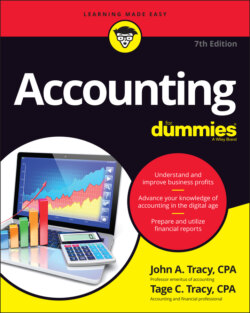Читать книгу Accounting For Dummies - John A. Tracy - Страница 32
Accounting as a Form of Art
ОглавлениеThroughout this book, you read references to accounting being more of a form of art than an exact science. We are not implying that accountants and the profession of accounting don’t have to follow specific rules, standards, and guidelines; as you see in Chapter 2, a very robust set of rules and authoritative organizations have been established to provide guidance to accountants in plying their trade.
However, it should be noted that accounting is by no means an exact science because accountants are constantly having to use estimates, complete complex financial analyses, and evaluate data (that always seems to be a moving target) when preparing financial information, reports, and statements. Further, economic conditions are constantly changing and evolving at what seems like the speed of light these days (such as with Covid-19’s impact in 2020 and beyond), making the accountant’s job even more challenging. You would be amazed at how even the slightest change in an assumption or data point used, such as increasing the interest rate used to calculate the estimated current value of future obligations, can impact the overall financial results of a business.
To reiterate one of our primary goals, the purpose of the concepts and topics presented in this book is not to provide a detailed overview of technical accounting rules or guidelines, such as the theory behind accounting for capital asset leases or applying Black-Scholes to account for stock option expense, but rather to offer a 10,000-foot overview of accounting and key concepts every business must address, starting with the following fundamental statement.
To produce accurate financial information, every business must develop, implement, maintain, and manage a properly functioning accounting system that at its foundation relies on establishing, implementing, and adhering to agreed-upon accounting policies, procedures, and controls applied on a consistent basis and in accordance with generally accepted accounting principles (GAAP).
These generally accepted accounting principles are “a set of rules that encompass the details, complexities, and legalities of business and corporate accounting.” These rules are established by various accounting organizations, boards, and groups, with the primary group being the Financial Accounting Standards Board (FASB), which uses GAAP as the foundation for its comprehensive set of approved accounting methods and practices.
There you have it — when producing financial information, businesses should adhere to GAAP as established by FASB. Seems simple enough, but as you work through the remainder of this book, it should become abundantly clear that GAAP is more or less a series of guidelines that businesses can use to provide a certain amount of leeway when actual financial information is produced. Or maybe the best way to think of it is referring to this quote from Captain Barbossa from the Pirates of the Caribbean franchise: “And thirdly, the code (translation to accounting — GAAP) is more what you’d call guidelines than actual rules.” Yes, very good guidelines but guidelines nonetheless that provide accountants with a reasonable amount of leeway when preparing financial information.
